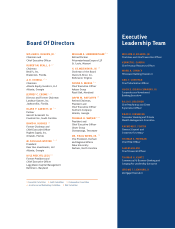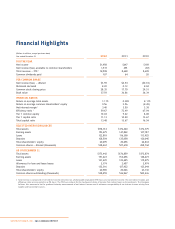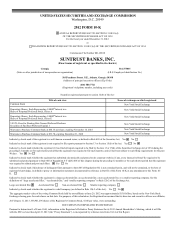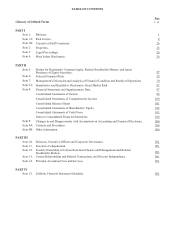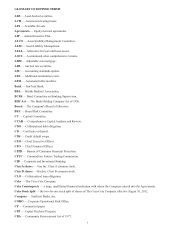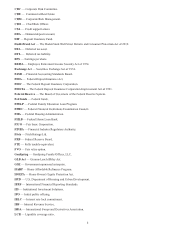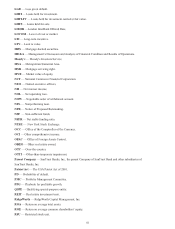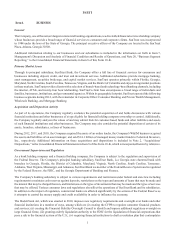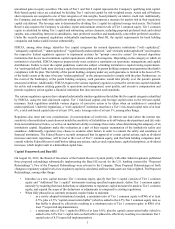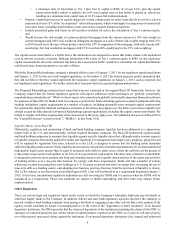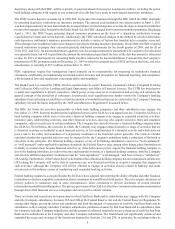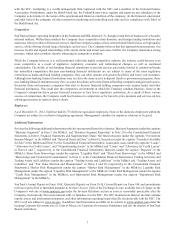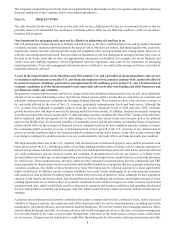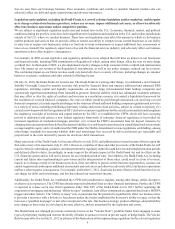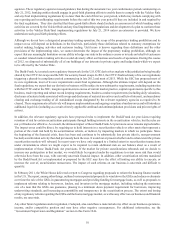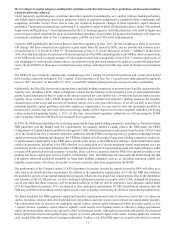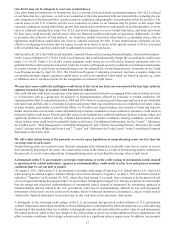SunTrust 2012 Annual Report Download - page 19
Download and view the complete annual report
Please find page 19 of the 2012 SunTrust annual report below. You can navigate through the pages in the report by either clicking on the pages listed below, or by using the keyword search tool below to find specific information within the annual report.
3
unrealized gain on equity securities. The sum of Tier 1 and Tier 2 capital represents the Company's qualifying total capital.
Risk-based capital ratios are calculated by dividing Tier 1 and total capital by risk-weighted assets. Assets and off-balance
sheet exposures are assigned to one of four categories of risk-weights, based primarily on relative credit risk. Additionally,
the Company, and any bank with significant trading activity, must incorporate a measure for market risk in their regulatory
capital calculations. The leverage ratio is determined by dividing Tier 1 capital by adjusted average total assets. The Federal
Reserve also requires the Company to calculate, report and maintain certain levels of Tier 1 common equity. Tier 1 common
equity is calculated by taking Tier 1 capital and subtracting certain elements, including perpetual preferred stock and related
surplus, non-controlling interests in subsidiaries, trust preferred securities and mandatorily convertible preferred securities.
Under the recently proposed regulations substantially implementing Basel III, the capital requirements for bank holding
companies and banks would increase substantially.
FDICIA, among other things, identifies five capital categories for insured depository institutions (“well capitalized,”
“adequately capitalized,” “undercapitalized,” “significantly undercapitalized,” and “critically undercapitalized”) and requires
the respective federal regulatory agencies to implement systems for “prompt corrective action” for insured depository
institutions that do not meet minimum capital requirements within such categories. Depending on the category in which an
institution is classified, FDICIA imposes progressively more restrictive constraints on operations, management, and capital
distributions. Failure to meet the capital guidelines could also subject a banking institution to capital raising requirements.
An “undercapitalized” bank must develop a capital restoration plan and its parent holding company must guarantee that bank's
compliance with the plan. The liability of the parent holding company under any such guarantee is limited to the lesser of 5%
of the bank's assets at the time it became “undercapitalized” or the amount needed to comply with the plan. Furthermore, in
the event of the bankruptcy of the parent holding company, such guarantee would take priority over the parent's general
unsecured creditors. Additionally, FDICIA requires the various regulatory agencies to prescribe certain non-capital standards
for safety and soundness relating generally to operations and management, asset quality, and executive compensation and
permits regulatory action against a financial institution that does not meet such standards.
The various regulatory agencies have adopted substantially similar regulations that define the five capital categories identified
by FDICIA, using the total risk-based capital, Tier 1 risk-based capital, and leverage capital ratios as the relevant capital
measures. Such regulations establish various degrees of corrective action to be taken when an institution is considered
undercapitalized. Under the regulations, a “well capitalized” institution must have a Tier 1 risk-based capital ratio of at least
6%, a total risk-based capital ratio of at least 10%, and a leverage ratio of at least 5%, among other things.
Regulators also must take into consideration: (i) concentrations of credit risk; (ii) interest rate risk (when the interest rate
sensitivity of an institution's assets does not match the sensitivity of its liabilities or its off-balance sheet position); and (iii) risks
from non-traditional activities, as well as an institution's ability to manage those risks, when determining the adequacy of an
institution's capital. Regulators make this evaluation as a part of their regular examination of the institution's safety and
soundness. Additionally, regulators may choose to examine other factors in order to evaluate the safety and soundness of
financial institutions. The Federal Reserve recently announced that its approval of certain capital actions, such as dividend
increases and stock repurchase, will be tied to the level of Tier 1 common equity, and that bank holding companies must
consult with the Federal Reserve's staff before taking any actions, such as stock repurchases, capital redemptions, or dividend
increases, which might result in a diminished capital base.
Capital Framework and Basel III
On August 30, 2012, the Board of Governors of the Federal Reserve System jointly with other federal regulators published
three proposed rulemakings substantially implementing the Basel III accord for the U.S. banking system (the “Proposed
Rulemakings”). Two of the Proposed Rulemakings were relevant to the Company. These Proposed Rulemakings set forth
changes to regulatory capital levels, how regulatory capital is calculated, and how bank assets are risk-weighted. The Proposed
Rulemakings, among other things:
• Introduce as a new capital measure Tier 1 common equity, specify that Tier 1 capital consists of Tier 1 common
equity and “Additional Tier 1 capital” instruments meeting specified requirements, define Tier 1 common equity
narrowly by requiring that most deductions or adjustments to regulatory capital measures be made to Tier 1 common
equity, and expand the scope of the deductions or adjustments as compared to existing regulations;
• When fully phased-in as currently proposed, require banks to maintain:
as a newly adopted international standard, a minimum ratio of Tier 1 common equity to RWA of at least
4.5%, plus a 2.5% “capital conservation buffer” (which is added to the 4.5% Tier 1 common equity ratio as
that buffer is phased-in, effectively resulting in a minimum ratio of Tier 1 common equity to RWA of at
least 7% upon full implementation);
a minimum ratio of Tier 1 capital to RWA of at least 6.0%, plus the capital conservation buffer (which is
added to the 6.0% Tier 1 capital ratio as that buffer is phased in, effectively resulting in a minimum Tier 1
capital ratio of 8.5% upon full implementation);


